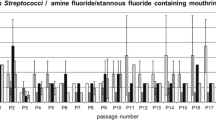Abstract
Twenty-eight strains of microaerophilic, motile, slightly curved gramnegative rods isolated from the gingival crevice of patients with gingivitis were studied. They seemed similar to Vibrio sputorum, though eleven strains differed in minor characters from Bergey's description under the new name Campylobacter sputorum, subspecies sputorum. The oral strains studied appeared to be closely related to several species of the genus Campylobacter and to Vibrio succinogenes.
The oral strains were able to utilize gaseous hydrogen and to grow in a mineral medium with either nitrate of fumarate as hydrogen acceptor. Formate could replace hydrogen as hydrogen donor. In contrast the Campylobacter strains were not dependent on hydrogen or formate as energy source and grew poorly in mineral medium. In these nutritional and metabolic aspects the oral strains are more related to Vibrio succinogenes than to Campylobacter species.
Serologically the oral strains differed from all the Campylobacter species. The GC ratio in the DNA of the oral strains varied between 48 and 50%, conform to the values described for Vibrio succinogenes. Vibrio sputorum seems a nomen conservandum and vibrio-like organisms from human infections should be tested for hydrogen-dependence before they are classified as Campylobacter species.
Similar content being viewed by others
References
Barnes, E. M. and Goldberg, H. S. 1962. The isolation of anaerobic gram-negative bacteria from poultry reared with and without antibiotic supplements. — J. Appl. Bacteriol. 25: 94–106.
Berg, R. L., Jutila, J. W. and Firehammer, B. D. 1971. A revised classification of Vibrio fetus. — Am. J. Vet. Res. 32: 1–22.
Bergey's Manual of determinative bacteriology, 1974, Eighth edition. — Williams and Wilkins Comp. Baltimore.
Butzler, J. P., Dekeyser, P., Detrain, M. and Dehaen, F. 1973. Related vibrio in stools. — J. Pediatr. 82: 493–495.
Charlier, G., Dekeyser, P., Florent, A., Strobbe, R. and Deley, J. 1974. DNA base composition and biochemical characters of Campylobacter strains. — Antonie van Leeuwenhoek 40: 145–151.
Crombach, W. H. J. 1972. DNA base composition of soil arthrobacters and other coryneforms from cheese and sea fish. — Antonie van Leeuwenhoek 38: 105–120.
Crombach, W. H. J. 1973. Deep-freezing of bacterial DNA for thermal denaturation and hybridization experiments. — Antonie van Leeuwenhoek, 39: 249–255.
Dekeyser, P., Gossuin-Detrain, M., Butzler, J. P. and Sternon, J. 1972. Acute enteritis due to related vibrio: First positive stool cultures. — J. Infect. Dis. 125: 390–392.
DeLey, J. 1970. Reexamination of the association between melting point, buoyant density and chemical base composition of deoxyribonucleic acid. — J. Bacteriol. 101: 738–754.
Dwyer, M. D. and Socransky, S. S. 1968. The predominant cultivable micro-organisms inhabiting periodontal pockets. — Brit. Dent. J. 116: 560–564.
Hill, L. R. 1966. An index to deoxyribonucleic acid base compositions of bacterial species. —J. Gen. Microbiol. 44: 419–437.
Kafkewitz, D. and Goodman, D. 1974. l-Asparaginase production by the rumen anaerobe Vibrio succinogenes. — Appl. Microbiol. 27: 206–209.
King, E. O. 1957. Human infections with Vibrio fetus and a closely related vibrio. — J. Infect. Dis. 101: 119–128.
King, E. O. 1962. The laboratory recognition of Vibrio fetus and a closely related vibrio isolated from cases of human vibriosis. — Ann N. Y. Acad. Sci. 98: 700–711.
Loesche, W. J., Gibbons, R. J. and Socransky, S. S. 1965. Biochemical characteristics of Vibrio sputorum and relationship to Vibrio bubulus and Vibrio fetus. — J. Bacteriol. 89: 1109–1116.
Loesche, W. J. 1968. Some energy sources of Vibrio sputorum. — Abstract 475 pg. 156 I.A.D.R. abstracts.
Macdonald, J. B. 1953. The motile non-sporulating anaerobic rods of the oral cavity. —Thesis University of Toronto, Toronto, Canada.
Maertzdorf, W. J. en Mouton, R. P. 1974. Infecties met Vibrio foetus op een zuigelingenafdeling. — Ned. T. Geneesk. 118: 609–613.
Middelkamp, J. N. and Wolf, H. A. 1961. Infection due to a related vibrio. — J. Pediatr. 59: 318–321.
Niederman, R. A. and Wolin, M. J. 1972. Requirement of succinate for the growth of Vibrio succinogenes. — J. Bacteriol. 109: 546–549.
van Palenstein Helderman, W. H. 1975. Total viable count and differential count of Vibrio (Campylobacter) sputorum, Fusobacterium nucleatum, Selenomonas sputigena, bacteroides ochraceus and Veillonella in the inflamed and non inflamed human gingival crevice. — J. Periodontal Res. 10: 294–305.
van Palenstein Helderman, W. H. and Winkler, K. C. 1975. Elective medium for the direct count of Vibrio (Campylobacter), Fusobacteria, Bacteroides, Selenomonas and Veillonella in the gingival crevice flora. — J. Periodontal Res. 10: 230–241.
Sebald, M. et Véron, M. 1963. Teneur en base de l'ADN et classification des vibrions. —Ann. Inst. Pasteur 105: 897–910.
Vinzent, R. 1947. Abortion following severe septicaemia due to Vibrio fetus. — Bull. Acad. Nat. Méd. (Paris) 131: 90–92.
van Wering, R. F. and Esseveld, H. 1963. Vibrio fetus. — Ned. T. Geneesk. 107: 119–121.
Winter, A. J. and Dunne, H. W. 1962. An antigenic analysis of Vibrio fetus. I. Properties of soluble extracts of the organism. — Am. J. Vet. Res. 23: 150–158.
Wolin, M. J., Wolin, E. A. and Jacobs, N. J. 1961. Cytochrome-producing anaerobic vibrio, Vibrio succinogenes, SP.N. — J. Bacteriol 81: 911–917.
Author information
Authors and Affiliations
Rights and permissions
About this article
Cite this article
van Palenstein Helderman, W.H., Rosman, I. Hydrogen-dependent organisms from the human gingival crevice resembling Vibrio succinogenes . Antonie van Leeuwenhoek 42, 107–118 (1976). https://doi.org/10.1007/BF00399454
Received:
Issue Date:
DOI: https://doi.org/10.1007/BF00399454



